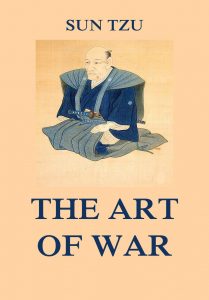The Art of War – Sun Tzu
“The Art of War” is widely known as the masterpiece of the Chinese general and philosopher Sun Tzu. The book is a highly acclaimed tutorial for managing conflicts and winning battles, not only in the military meaning, but also in career and life management. Sun Tzus theories are extremely popular among politicians and leaders in marketing and communication.
Format: Paperback.
The Art of War
ISBN: 9783849681890
Available at amazon.com and other venues.
Chapter summary of The Art of War (from Wikipedia):
Detail Assessment and Planning (Chinese: 始計,始计) explores the five fundamental factors (the Way, seasons, terrain, leadership, and management) and seven elements that determine the outcomes of military engagements. By thinking, assessing and comparing these points, a commander can calculate his chances of victory. Habitual deviation from these calculations will ensure failure via improper action. The text stresses that war is a very grave matter for the state and must not be commenced without due consideration.
Waging War (Chinese: 作戰,作战) explains how to understand the economy of warfare and how success requires winning decisive engagements quickly. This section advises that successful military campaigns require limiting the cost of competition and conflict.
Strategic Attack (Chinese: 謀攻,谋攻) defines the source of strength as unity, not size, and discusses the five factors that are needed to succeed in any war. In order of importance, these critical factors are: Attack, Strategy, Alliances, Army and Cities.
Disposition of the Army (Chinese: 軍形,军形) explains the importance of defending existing positions until a commander is capable of advancing from those positions in safety. It teaches commanders the importance of recognizing strategic opportunities, and teaches not to create opportunities for the enemy.
Forces (Chinese: 兵勢,兵势) explains the use of creativity and timing in building an army’s momentum.
Weaknesses and Strengths (Chinese: 虛實,虚实) explains how an army’s opportunities come from the openings in the environment caused by the relative weakness of the enemy and how to respond to changes in the fluid battlefield over a given area.
Military Maneuvers (Chinese: 軍爭,军争) explains the dangers of direct conflict and how to win those confrontations when they are forced upon the commander.
Variations and Adaptability (Chinese: 九變,九变) focuses on the need for flexibility in an army’s responses. It explains how to respond to shifting circumstances successfully.
Movement and Development of Troops (Chinese: 行軍,行军) describes the different situations in which an army finds itself as it moves through new enemy territories, and how to respond to these situations. Much of this section focuses on evaluating the intentions of others.
Terrain (Chinese: 地形) looks at the three general areas of resistance (distance, dangers and barriers) and the six types of ground positions that arise from them. Each of these six field positions offers certain advantages and disadvantages.
The Nine Battlegrounds (Chinese: 九地) describes the nine common situations (or stages) in a campaign, from scattering to deadly, and the specific focus that a commander will need in order to successfully navigate them.
Attacking with Fire (Chinese: 火攻) explains the general use of weapons and the specific use of the environment as a weapon. This section examines the five targets for attack, the five types of environmental attack and the appropriate responses to such attacks.
Intelligence and Espionage (Chinese: 用間,用间) focuses on the importance of developing good information sources, and specifies the five types of intelligence sources and how to best manage each of them.
(The text of the last section was taken from a Wikipedia entry and is available under the Creative Commons Attribution-ShareAlike License.)
Publisher’s Note: This book is printed and distributed by Createspace a DBA of On-Demand Publishing LLC and is typically not available anywhere else than in stores owned and operated by Amazon or Createspace.

